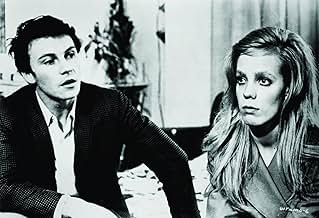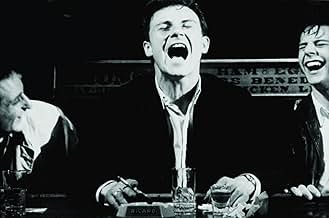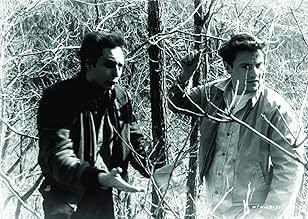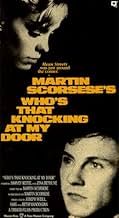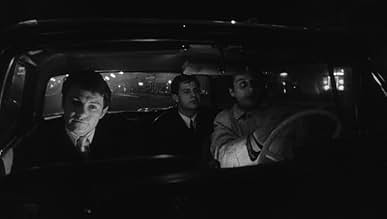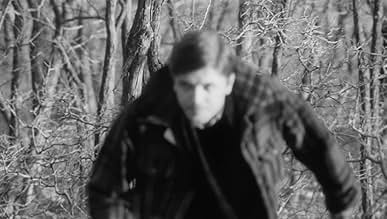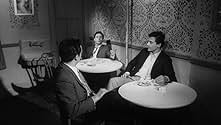A young man can't accept the girl he likes because of her bitter past.A young man can't accept the girl he likes because of her bitter past.A young man can't accept the girl he likes because of her bitter past.
- Director
- Writers
- Stars
- Awards
- 1 nomination total
Anne Collette
- Girl in Dream
- (as Ann Collette)
Philip Carlson
- Boy in Copake
- (as Phil Carlson)
Marrissa Joffre
- Girl at Party
- (as Marrisa Joffrey)
Victor Magnotta
- Boy in Fight
- (as Vic Magnotta)
Thomas Aiello
- Minor Role
- (uncredited)
- Director
- Writers
- All cast & crew
- Production, box office & more at IMDbPro
Featured reviews
A well-dressed but feckless young man (Harvey Keitel, in his acting debut) on the streets of New York meets a lovely single girl reading a foreign magazine and strikes up a conversation about movies; soon after, they begin dating, however she volunteers more about her past than he is able to handle. Striking if aimless debut from writer-director Martin Scorsese, alternately titled "I Call First", began life as a short feature from the young film student. His sexual montage, featuring Keitel and his 'broads' (and set to "The End" by the Doors), is a fabulous example of cinematic sound and fury: the perfect marriage between silvery black-and-white cinematography, kinetic editing, great music and lusty bodies. Unfortunately, Scorsese as a writer had not developed a true ear for canny dialogue, and the characters fail to emerge as a result. Still, an almost-dynamic first try, and a must-see for film historians. Keitel, marvelously youthful and muscular, is more callow than expressive, though he gives the picture its pulse; the cinematography from Richard Coll and Michael Wadley is a major asset as well. **1/2 from ****
"Who's That Knocking At My Door?" (1968) is the kind of film where you see it once you'll want to see it again, just to see what you didn't understand. The protagonist is played by Harvey Keitel as J.R., an autobiographical role based loosely on Scorsese's strict Catholic upbringing. And many symbolic Catholic references there are such as the Virgin Mary mini statue reflection in the mirror watching Harvey Keitel's JR as he embraces "The Young Girl" played by Zina Bethune.
Scorsese is so intelligent and inventive with his scenes here; crafty artsiness at its best (like the one where J.R. is having sex with the "broad" in a dream fantasy, but then afterwards flips his cards towards her rejecting her as a sin; she's not a nice virgin who would be a good wife and mother for J.R.; she's just a whore, a "broad", as we listen to The Doors' song 'The End' finish). Marty's own personal style was established in this early film.
Harvey Keitel was 29-years-old when Martin Scorsese's [who was 25] "Who's That Knocking At My Door?" debuted in 1968. This was a full-length feature debut for both actor Keitel and director Scorsese. It was interesting to see this for the first time recently after I had already seen most of Scorsese's later films. His classic trade marks such as the "freeze frame, slow-motion, and classic rock tracks playing on the soundtrack" are all utilized effectively in this early gem. ("Easy Rider" is always the film that is credited as being the originator of playing classic rock tunes on the soundtrack, but "Who's That Knocking At My Door?" wasn't seen by many until it received wide release in 1970, almost three years after it was made.)
For any film school student or aspiring director/screenwriter this is a must see. Mr. Scorsese financed this film on a tight budget. I read somewhere that his film professor from NYU helped him finance it. From the beginning somebody somewhere knew Marty had the talent and could make a good picture. He created a wonderful film; using his own life experience for the story he was able to concoct a great, interesting and personal film. His "Mean Streets" (1973) is a much greater and even more personal film. But "Who's That Knocking At My Door?" was the beginning.
I'm not Catholic but I certainly learn a lot about Catholicism when I watch a Scorsese flick. For instance, take the scene where "The Young Girl" is making dinner at J.R.'s place, she lights up what appears to be just a candle. But to J.R. it is a "Holy Candle" and makes her put it back and replace it with another one. There are many classic scenes in this film, but I don't want to spoil it for you.
Directed by Martin Scorsese. Edited By Thelma Schoonmaker (who would go on to edit almost all of Scorsese's later films). Starring Harvey Keitel as J.R. 90 minutes.
Scorsese is so intelligent and inventive with his scenes here; crafty artsiness at its best (like the one where J.R. is having sex with the "broad" in a dream fantasy, but then afterwards flips his cards towards her rejecting her as a sin; she's not a nice virgin who would be a good wife and mother for J.R.; she's just a whore, a "broad", as we listen to The Doors' song 'The End' finish). Marty's own personal style was established in this early film.
Harvey Keitel was 29-years-old when Martin Scorsese's [who was 25] "Who's That Knocking At My Door?" debuted in 1968. This was a full-length feature debut for both actor Keitel and director Scorsese. It was interesting to see this for the first time recently after I had already seen most of Scorsese's later films. His classic trade marks such as the "freeze frame, slow-motion, and classic rock tracks playing on the soundtrack" are all utilized effectively in this early gem. ("Easy Rider" is always the film that is credited as being the originator of playing classic rock tunes on the soundtrack, but "Who's That Knocking At My Door?" wasn't seen by many until it received wide release in 1970, almost three years after it was made.)
For any film school student or aspiring director/screenwriter this is a must see. Mr. Scorsese financed this film on a tight budget. I read somewhere that his film professor from NYU helped him finance it. From the beginning somebody somewhere knew Marty had the talent and could make a good picture. He created a wonderful film; using his own life experience for the story he was able to concoct a great, interesting and personal film. His "Mean Streets" (1973) is a much greater and even more personal film. But "Who's That Knocking At My Door?" was the beginning.
I'm not Catholic but I certainly learn a lot about Catholicism when I watch a Scorsese flick. For instance, take the scene where "The Young Girl" is making dinner at J.R.'s place, she lights up what appears to be just a candle. But to J.R. it is a "Holy Candle" and makes her put it back and replace it with another one. There are many classic scenes in this film, but I don't want to spoil it for you.
Directed by Martin Scorsese. Edited By Thelma Schoonmaker (who would go on to edit almost all of Scorsese's later films). Starring Harvey Keitel as J.R. 90 minutes.
"Who's that knocking at my door" is along with "Boxcar Bertha" the most unknown picture of the Italian-American genius Scorsese. Make no mistakes: it's nothing like a masterpiece and it's no surprise that almost no one know about this movie, but here we got some of the constants in Marty's cinema: the street talking, the violence, the outsiders... Those things that "mean streets" dealt about... This was Martin Scorsese's debut and so it was for his friend Harvey Keytel who plays a chauvinist-bad tempered young man.
So, this is a movie that I recommend to those who really love Scorsese's work and wanna know about his origins.
*My rate: 6/10
So, this is a movie that I recommend to those who really love Scorsese's work and wanna know about his origins.
*My rate: 6/10
This is a hard movie to review because it's essentially an amalgam of several different shorter student films, and some work better than others.
That said, at the crux of "Who's That Knocking at My Door" (the final mass-released version) is a complex character-study laden with Catholic guilt and burdened by all the inherent stigmas and traditions of growing up Italian-American.
Obviously Scorsece knew his source material very well. More than half of the players and virtually all the locations come straight from his own life. What's really cool about the film, though, is how honestly he portrays these sociological nuances. He doesn't tell you Keitel's character's views and attitudes are good or bad, they just "are" --- and it's obvious how the character developed them from a peek into his everyday world.
This bracing honesty is the most appealing thing about the film, along with some drop-dead gorgeous camera work and editing featured here. The first scene where Keitel meets Bethune on the ferry has got to be one of the most imaginatively-shot and enthrallingly staged boy-meets-girl moments on celluloid. Throughout the film, Scorcese overlays soundless scenes from the past and future, creating interesting juxtapositions, always engaging and challenging your perceptions.
With a lot of debuts there are missteps. I don't think that fairly characterizes this movie however. There are definitely parts that drag and don't work well but seen in the context of a shorter film, they would have been more effective. As they're all blended together here, the pacing sometimes suffers.
It's hard to imagine any of the fans of Scorsece's later works, which rely so heavily on hyper-real camera-work and tightly-structured story lines, to have the patience for "Who's That Knocking." But for those who really enjoy the thoughtfulness, subversiveness, and subtext of Scorcese's films, it's a treat to see their origins so prominently displayed.
That said, at the crux of "Who's That Knocking at My Door" (the final mass-released version) is a complex character-study laden with Catholic guilt and burdened by all the inherent stigmas and traditions of growing up Italian-American.
Obviously Scorsece knew his source material very well. More than half of the players and virtually all the locations come straight from his own life. What's really cool about the film, though, is how honestly he portrays these sociological nuances. He doesn't tell you Keitel's character's views and attitudes are good or bad, they just "are" --- and it's obvious how the character developed them from a peek into his everyday world.
This bracing honesty is the most appealing thing about the film, along with some drop-dead gorgeous camera work and editing featured here. The first scene where Keitel meets Bethune on the ferry has got to be one of the most imaginatively-shot and enthrallingly staged boy-meets-girl moments on celluloid. Throughout the film, Scorcese overlays soundless scenes from the past and future, creating interesting juxtapositions, always engaging and challenging your perceptions.
With a lot of debuts there are missteps. I don't think that fairly characterizes this movie however. There are definitely parts that drag and don't work well but seen in the context of a shorter film, they would have been more effective. As they're all blended together here, the pacing sometimes suffers.
It's hard to imagine any of the fans of Scorsece's later works, which rely so heavily on hyper-real camera-work and tightly-structured story lines, to have the patience for "Who's That Knocking." But for those who really enjoy the thoughtfulness, subversiveness, and subtext of Scorcese's films, it's a treat to see their origins so prominently displayed.
a definite must for all scorsese fans. runs much like a student film. Use of music is still very ruff in this film. Not nearly as effective as in mean streets. Many of the same ideas scorsese will later work out in mean streets. Harvey Keitel's performance is powerful. Filmed mostly on Elizabeth St where scorsese grew up and his childhood apartment. highly recommended
What Scorsese Film Ranks Highest on IMDb?
What Scorsese Film Ranks Highest on IMDb?
Cinema legend Martin Scorsese has directed some of the most acclaimed films of all time. See how IMDb users rank all of his feature films as director.
Did you know
- TriviaIn order to get distribution for his film, Martin Scorsese was told to add nude scenes so it could be promoted as a "sexploitation" movie. He thus shot the fantasy scene showing J.R. imagining encounters with prostitutes.
- GoofsMartin Scorsese utilizes the black and white nature of film to hide the lack of time and day continuity in some scenes.
- Crazy creditsThere is a big "Thanks to the County and City of New York" in the end credits.
- Alternate versionsEarly versions of this film were screened without the erotic fantasy scene.
- ConnectionsFeatured in Une décennie sous influence (2003)
- SoundtracksJenny Take a Ride
(uncredited)
Written by Bob Crewe, Enotris Johnson, and Little Richard
Performed by Mitch Ryder & The Detroit Wheels
Details
- Release date
- Country of origin
- Official sites
- Language
- Also known as
- Bring on the Dancing Girls
- Filming locations
- Amsterdam, Noord-Holland, Netherlands(as New York, only interior, scenes with nudity)
- Production companies
- See more company credits at IMDbPro
Box office
- Budget
- $75,000 (estimated)
- Gross worldwide
- $16,085
- Runtime
- 1h 30m(90 min)
- Color
- Sound mix
- Aspect ratio
- 1.85 : 1
Contribute to this page
Suggest an edit or add missing content

